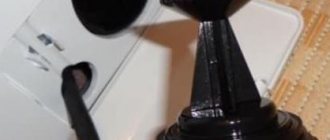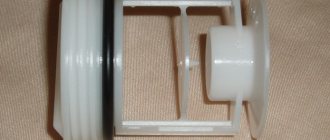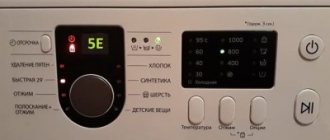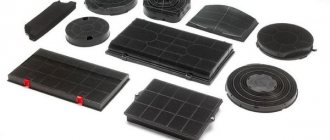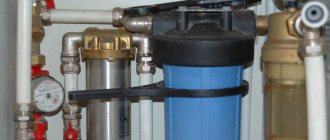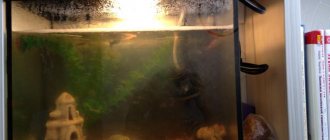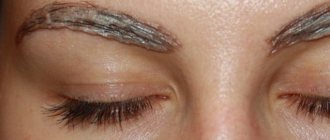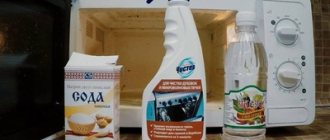What determines the frequency of maintenance of an aquarium filter?
It is common for novice aquarists to make mistakes in their pond care schedule. Rare cleaning, as well as too frequent cleaning, is harmful to the aqua system and can cause problems. Factors influencing the frequency of aquarium maintenance:
- Aquarium volume. Ponds that are too small need to be cleaned more often than large ones, because in large aquariums the aquatic system is more stable.
- Number of living fish. The more inhabitants there are, the more often you will have to clean it. By adding more feed, waste increases.
- Number of natural plants. Living plants serve as a biological filter for the aquatic system. They are involved in processing waste, absorbing harmful substances, and cleaning the reservoir.
- Bacteria. This is the basis of biological filtration. They are engaged in primary waste processing. Their action affects the stability of the aquatic system.
- Filtration. The filter is selected according to the volume of the aquarium. The installed mechanism must be able to cope with the volume of waste and create a sufficient level of water circulation. The frequency of treatment of the aquarium filter depends on how the filtration is performed.
- Feeding. The reservoir is also polluted due to overfeeding of fish. Feeding is best done in moderation.
- Failure to maintain the correct aquarium maintenance regime. Due to excessive lighting, walls and decorations become dirty, and problems with algae appear. Excessive application of fertilizers leads to this effect.
For continuous filtration, a constant flow of oxygen is required to the filter material. Interruptions in the supply of oxygen, which is dissolved in water, can occur due to two circumstances:
- If the filter material is not cleaned from mechanical contamination in a timely manner. Excess dirt interferes with the flow of oxygen and saprophytes (plant organisms that feed on dead organic matter) do not decompose organic matter as they should.
- Interruptions in the functioning of the aquarium filter. If there is no oxygen supply, beneficial bacteria will die off. Due to prolonged stoppages in the operation of the filter, colonies of microorganisms will die. Such a situation will lead to reverse processes in the filter, and the dead saprophytes will begin to release toxic substances into the water: hydrogen sulfide, methane, ammonia and carbon dioxide. If a filter that does not work for a long time is connected, streams of contaminants with an unpleasant odor will flow into the water, poisoning the inhabitants of the aquarium.
Internal organization
High reliability and long service life (on average 10 years) are ensured due to the simplicity of the internal structure of the filtration equipment.
An electric pump is located in a plastic cylindrical body to draw water through the holes. The liquid is passed under pressure through the filter material, and mechanical impurities are removed.
At the same time, biological treatment occurs. Colonies of saprophytes are formed in the cells of elastic polyurethane foam, which process organic matter.
An aeration tube with a nozzle and a regulator, in the absence of a compressor, will saturate the water with oxygen in the required concentration. The package includes accessories: when installed in different combinations, you can change the design of the filter and its functionality.
Aquael FAN has a regulator with which you can simulate flow in the aquarium. For some species of fish, its presence is an important condition for creating comfortable living conditions that are as close to natural as possible.
To adjust the flow strength, there is a manual regulator, the position of which can be changed without immersing your hands in the water. When using this function, the aeration intensity decreases, which should be taken into account when setting up the equipment.
The design of the perforated rod is made in such a way that the dirt contained in the processed water is distributed evenly over the entire area of the filter sponge. It is not concentrated only in its upper part.
Due to this, the efficiency of removing impurities increases. To reduce the level of vibration during operation of the equipment, the fixing suction cups of the powerful FAN 2 and 3 models are equipped with a shock absorber.
Signs of dirty filter elements
Filter models are different and devices for small aquariums need to be cleaned more often than those for large ones. When determining contamination, you need to take a closer look at the water flow from the device. If the flow becomes weaker, then this is a sign that flushing is required. If the water in the reservoir becomes cloudy, this also serves as a signal that the filter is dirty.
A few words about the manufacturer
Aquael is a Polish manufacturer of equipment and accessories for aquariums, producing filters, pumps, heaters, components and consumables that may be needed during maintenance.
The products comply with the requirements of current regulatory documents and are supplied with quality and safety certificates.
The brand’s equipment operates reliably and has a long service life, which is appreciated by European consumers.
For production, high quality plastic is used, which is resistant to mechanical damage. The surface of the material does not allow the formation of deposits.
How to properly clean filters?
It is important that these devices work efficiently, saturating the aquarium water with oxygen.
Despite the differences in brands and power, the filtration devices are similar. For this reason, both internal and external filters are cleaned according to the above example. There are two types of cleaning aquarium filters:
- cleaning filter elements;
- complete cleaning (filter elements and mechanical ones are cleaned).
Filter elements are cleaned regularly as they become dirty. Complete cleaning is recommended when microorganisms with other deposits interfere with the normal functioning of the device. Do not forget that sterile purity of filter materials is not necessary. Such actions will lead to the washing out of beneficial bacteria that perform biological purification of water and maintain the biobalance in the reservoir.
Water should flow evenly through the filter media. Water flows along the simplest path it finds. When using fillers in bags, you need to ensure their even distribution. To do this, just make sure that the bags fit snugly against the walls in the filter chamber.
The mistake some aquarists make is that they turn off the aerator filter at night. This threatens damage to the aquatic system. At night, the need for oxygen increases. This happens because it is not released from plants in dark conditions, but is absorbed by them.
There is a statement that the filter power per hour should be three times the volume of the aquarium. In this case, if the aquarium volume is 100 liters, you will need a filter device capable of providing a throughput of 300 liters per hour. These are average values, but in some situations limited or increased filtration is required.
If you use a filter more powerful than needed for the aquarium, this will negatively affect the plants, and for many of them, strong water pressure is only harmful.
In addition, an excess of oxygen during the day will not be beneficial for them, because they receive nutrition in the form of carbon dioxide dissolved in water.
What will you need?
When processing filter material, it is not recommended to use chemical detergents and soap. Residues from them are harmful to the inhabitants of the aquarium. When cleaning, you will not need to use any additional substances; rinsing with running water (but not hot) will suffice.
It’s just important not to get too carried away with the washing process; perfect sterility is not needed in this case.
We will need:
- bucket;
- rag;
- pelvis;
- cotton buds;
- old toothbrush;
- small package;
- disposable filter material for replacement;
- Activated carbon.
Preparation
The flushing process should begin between changes of water in the reservoir. It is important to maintain biobalance in the aquarium. The filter is removed from the aquarium. Then disassemble the device. To complete the process as quickly as possible, it is better to prepare the necessary things in advance.
Compliance with safety regulations
In addition to harmful bacteria, the filter material also contains beneficial organisms. It is better to plan flushing not during a period of dramatic changes (change of water, introduction of new fish, addition of new food). In such cases, a change in biobalance occurs. Filters are precisely considered regulators that maintain biological balance in a reservoir.
It is not recommended to wash the internal filter at the same time as other items in the aquarium. The filter elements are washed with aquarium water. Washing the ceramic filler (if there is one) is performed no more than once a month. It is not recommended to rinse the filter material with hot water.
Cleaning the bottom filter
The rules for caring for such a device are not complicated at first glance. You will need to wash the bottom filter (false bottom) approximately once every three to four months. If there are a large number of plants in the aquarium, its use is unacceptable, because the soil will no longer contain nutrients. Even taking into account the fact that branded models of bottom devices have a large number of technological holes, in order to clean it you will need to remove it from the aquarium.
Cleaning the external filter unit
In order not to damage the surface of the bathroom, it is better to place all parts in a basin. It is better to wash the filter sponge in a bucket. When disconnecting the hoses, you will need to use a rag to remove the water. To disassemble, open the lid to remove all the parts. They are installed in the reverse order.
The coarse sponge may need to be replaced. Then the walls of the filter apparatus and its plastic parts are cleaned. Don't forget to clean the magnetic rotor with a toothbrush or cotton swabs. To get to it, you need to twist and pull out the guide that secures the entire device. The parts and sponges are washed with siphoned aquarium or boiled water, and the filter is put back together.
Cleaning the internal filter
The device is disassembled into its component parts. All elements are washed: filter material, containers, motor, cap. We clean the internal cavity using cotton swabs. The air intake adapter needs to be washed. Use a needle to clean the holes. The device is assembled and installed back.
Types of Aquael FAN filters
The Aquael FAN line of internal filters is represented by 5 models. The choice is determined by the volume of the aquarium, which determines the performance requirements (from 250 to 700 l/h) and the power of the device.
The FAN MIKRO filter has been developed for aquariums up to 30 liters in volume. Its design allows for more efficient operation at a level of 3 cm from the surface in comparison with analogues on the market.
Due to this property, the model is often installed in palludariums, aquaterrariums, and swimming pools located in terrariums.
During operation, experts recommend taking into account that during aeration the evaporation process increases and this causes a decrease in the water level.
The FAN MINI model with a capacity of 260 l/h is designed for installation in containers of 30‑60 l. Aquael filters 1, 2 and 3 are recommended for installation in aquariums of 60‑100 l, 100‑150 l and 150‑250 l respectively.
How often should internal fillers be changed?
Foam fillers can last as long as the filter itself. In extreme cases, this is determined by appearance. The remaining fillers are also used repeatedly (even for several years). The functioning of all fillers also needs to be closely monitored, but it is not immediately necessary to think about replacing them.
It is worth noting that disassembling, cleaning, and assembling aquarium filters must be done without delay. This will not cause much damage to the aquatic system. After the work is completed, the process of full biological filtration will be restored.
